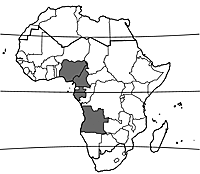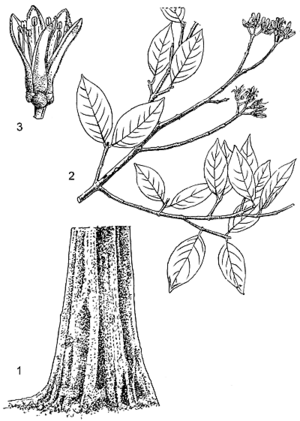Ctenolophon englerianus (PROTA)
Introduction |
Ctenolophon englerianus Mildbr.
- Protologue: Notizbl. Bot. Gart. Berlin-Dahlem 8: 706 (1924).
- Family: Ctenolophonaceae
Origin and geographic distribution
Ctenolophon englerianus occurs from southern Nigeria to Gabon and northern Angola.
Uses
The wood, known as ‘okip’ in Gabon, is used for heavy construction in house building, also for poles, and for canoes. The buttresses have been used for rifle-butts. The wood is suitable for heavy flooring, mine props, vehicle bodies, railway sleepers, sporting goods and agricultural implements. It is used as firewood. The bark is used for walls of huts.
Production and international trade
The wood of Ctenolophon englerianus is used locally and rarely traded on the international market.
Properties
The heartwood is reddish brown, sometimes with purplish streaks, and indistinctly demarcated from the sapwood. The grain is usually straight, texture fine. The wood contains oil deposits and tyloses.
The wood is heavy, with a density of 920–970 kg/m³ at 12% moisture content, hard and tough. The tendency of warping, checking and splitting during drying is high and it is recommended to dry the wood carefully and slowly. The shrinkage rates are quite high, from green to oven dry 5.9–6.5% radial and 9.0–9.3% tangential. Once dry, the wood is moderately stable in service. At 12% moisture content, the modulus of rupture is 182–240 N/mm², modulus of elasticity 14,600–16,850 N/mm², compression parallel to grain 71–96 N/mm², shear 9.5–10.5 N/mm², cleavage 14–27 N/mm and Chalais-Meudon side hardness 7.5–18.2.
The wood is rather difficult to saw and work with both hand and machine tools. The blunting effect on saw teeth and cutting edges is quite severe. Mortising, moulding and planing operations are difficult, although the results are usually satisfactory. Pre-boring is needed for nailing and screwing. The wood is durable, being resistant to termite and Lyctus attacks, but liable to marine borers. It is resistant to treatment with preservatives.
Description
- Small to medium-sized tree up to 25(–30) m tall; bole usually straight, up to 80 cm in diameter, fluted at base and with steep buttresses; bark surface smooth, brown, becoming scaly with irregular, small, peeling scales, inner bark pinkish; crown rounded, irregular; twigs with stellate hairs.
- Leaves opposite, simple and entire; stipules interpetiolar, caducous; petiole 3–6 mm long, slightly grooved; blade ovate to elliptical, 3.5–8.5 cm × 2–5 cm, cuneate at base, short-acuminate at apex, leathery, glabrous, pinnately veined with 6–8 pairs of lateral veins.
- Inflorescence a terminal panicle, short-hairy with stellate hairs.
- Flowers bisexual, regular, 5-merous, sweet-scented; pedicel c. 2 mm long; sepals free, rounded, 2–4 mm in diameter, minutely hairy; petals free, oblong, 1–1.5 cm long, minutely hairy outside, greenish yellow to pinkish; stamens 10, free, 1–1.5 cm long, whitish; ovary superior, elongated, densely hairy, 2-celled, style long, 2-lobed.
- Fruit a cylindrical capsule 1.5–2 cm long, longitudinally striped, glossy brown, dehiscing with 2 valves, 1-seeded.
- Seed up to 1.5 cm long, with comb-like, fibrous aril.
Other botanical information
Ctenolophon is a small genus comprising 2 widely separated species, one occurring in tropical Africa and the other in tropical Asia. Formerly, it has been placed in the family Linaceae.
Anatomy
Wood-anatomical description (IAWA hardwood codes):
- Growth rings: 2: growth ring boundaries indistinct or absent.
- Vessels: 5: wood diffuse-porous; 9: vessels exclusively solitary (90% or more); 14: scalariform perforation plates; 16: scalariform perforation plates with 10–20 bars; 17: scalariform perforation plates with 20–40 bars; (21: intervessel pits opposite); 22: intervessel pits alternate; 25: intervessel pits small (4–7 μm); 30: vessel-ray pits with distinct borders; similar to intervessel pits in size and shape throughout the ray cell; 41: mean tangential diameter of vessel lumina 50–100 μm; 48: 20–40 vessels per square millimetre; 58: gums and other deposits in heartwood vessels.
- Tracheids and fibres: 61: fibres with simple to minutely bordered pits; 62: fibres with distinctly bordered pits; (63: fibre pits common in both radial and tangential walls); 66: non-septate fibres present; 70: fibres very thick-walled.
- Axial parenchyma: 76: axial parenchyma diffuse; 77: axial parenchyma diffuse-in-aggregates; 78: axial parenchyma scanty paratracheal; 92: four (3–4) cells per parenchyma strand; 93: eight (5–8) cells per parenchyma strand.
- Rays: 97: ray width 1–3 cells; (98: larger rays commonly 4- to 10-seriate); (102: ray height > 1 mm); 107: body ray cells procumbent with mostly 2–4 rows of upright and/or square marginal cells; 108: body ray cells procumbent with over 4 rows of upright and/or square marginal cells; 113: disjunctive ray parenchyma cell walls present; 115: 4–12 rays per mm.
- Mineral inclusions: 136: prismatic crystals present; 137: prismatic crystals in upright and/or square ray cells; 138: prismatic crystals in procumbent ray cells; (140: prismatic crystals in chambered upright and/or square ray cells); 142: prismatic crystals in chambered axial parenchyma cells.
Growth and development
In Nigeria Ctenolophon englerianus flowers from March to April and from August to September, in Gabon from March to August. Fruits ripen soon after flowering, and flowers and ripe fruits can sometimes be found on the same tree.
Ecology
Ctenolophon englerianus occurs in freshwater swamp forest and riverine forest at low altitudes.
Management
Ctenolophon englerianus is locally gregarious. In some forests in western Gabon an average wood volume of 1.1 m³/ha has been recorded.
Genetic resources
Ctenolophon englerianus has a limited area of distribution, but it is locally common in suitable habitats. It is not commercially exploited and it does not seem to be liable to genetic erosion at present.
Prospects
Ctenolophon englerianus is a useful local source of wood, particularly valued because of its durability. It does not seem to have potential as a commercial timber source because it occurs only locally abundantly and often has a poor bole shape with deep grooves.
Major references
- Badré, F., 1973. Ctenolophonaceae. Flore du Gabon. Volume 21. Muséum National d’Histoire Naturelle, Paris, France. pp. 43–44.
- Bolza, E. & Keating, W.G., 1972. African timbers: the properties, uses and characteristics of 700 species. Division of Building Research, CSIRO, Melbourne, Australia. 710 pp.
- Burkill, H.M., 1985. The useful plants of West Tropical Africa. 2nd Edition. Volume 1, Families A–D. Royal Botanic Gardens, Kew, Richmond, United Kingdom. 960 pp.
- de Saint-Aubin, G., 1963. La forêt du Gabon. Publication No 21 du Centre Technique Forestier Tropical, Nogent-sur-Marne, France. 208 pp.
- Keay, R.W.J., 1989. Trees of Nigeria. A revised version of Nigerian trees (1960, 1964) by Keay, R.W.J., Onochie, C.F.A. & Stanfield, D.P. Clarendon Press, Oxford, United Kingdom. 476 pp.
- Raponda-Walker, A. & Sillans, R., 1961. Les plantes utiles du Gabon. Paul Lechevalier, Paris, France. 614 pp.
- Tailfer, Y., 1989. La forêt dense d’Afrique centrale. Identification pratique des principaux arbres. Tome 2. CTA, Wageningen, Pays Bas. pp. 465–1271.
- Takahashi, A., 1978. Compilation of data on the mechanical properties of foreign woods (part 3) Africa. Shimane University, Matsue, Japan. 248 pp.
Other references
- Badré, F., 1972. Ctenolophonaceae. Flore du Cameroun. Volume 14. Muséum National d’Histoire Naturelle, Paris, France. p. 46.
- Keay, R.W.J., 1958. Ctenolophonaceae. In: Keay, R.W.J. (Editor). Flora of West Tropical Africa. Volume 1, part 2. 2nd Edition. Crown Agents for Oversea Governments and Administrations, London, United Kingdom. p. 357.
- Normand, D. & Paquis, J., 1976. Manuel d’identification des bois commerciaux. Tome 2. Afrique guinéo-congolaise. Centre Technique Forestier Tropical, Nogent-sur-Marne, France. 335 pp.
- Sallenave, P., 1955. Propriétés physiques et mécaniques des bois tropicaux de l’Union française. Centre Technique Forestier Tropical, Nogent sur Marne, France. 129 pp.
- Sallenave, P., 1964. Propriétés physiques et mécaniques des bois tropicaux. Premier supplément. Centre Technique Forestier Tropical, Nogent-sur-Marne, France. 79 pp.
Sources of illustration
- de Saint-Aubin, G., 1963. La forêt du Gabon. Publication No 21 du Centre Technique Forestier Tropical, Nogent-sur-Marne, France. 208 pp.
- Keay, R.W.J., 1989. Trees of Nigeria. A revised version of Nigerian trees (1960, 1964) by Keay, R.W.J., Onochie, C.F.A. & Stanfield, D.P. Clarendon Press, Oxford, United Kingdom. 476 pp.
Author(s)
- E.A. Obeng, Forestry Research Institute of Ghana (FORIG), University P.O. Box 63, KNUST, Kumasi, Ghana
Correct citation of this article
Obeng, E.A., 2011. Ctenolophon englerianus Mildbr. [Internet] Record from PROTA4U. Lemmens, R.H.M.J., Louppe, D. & Oteng-Amoako, A.A. (Editors). PROTA (Plant Resources of Tropical Africa / Ressources végétales de l’Afrique tropicale), Wageningen, Netherlands.
Accessed 31 March 2025.
- See the Prota4U database.


